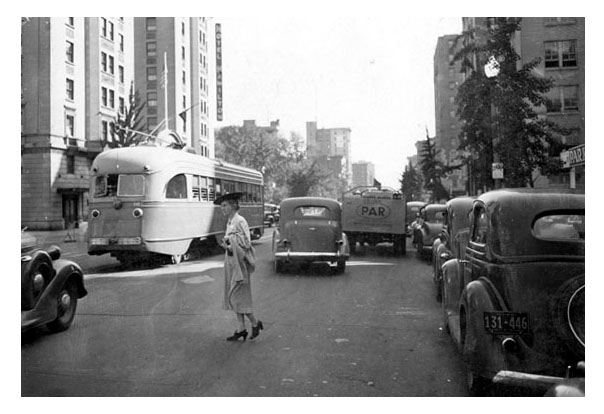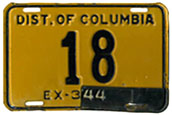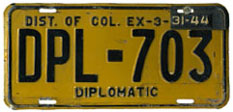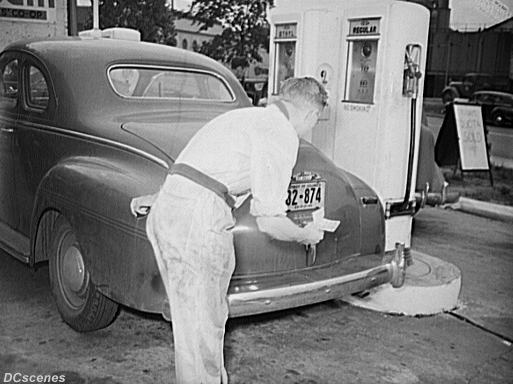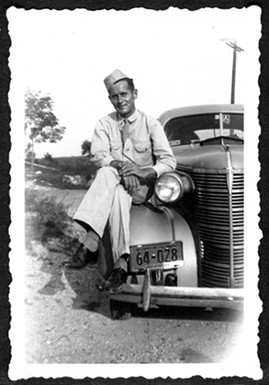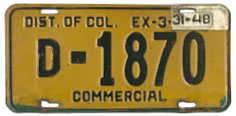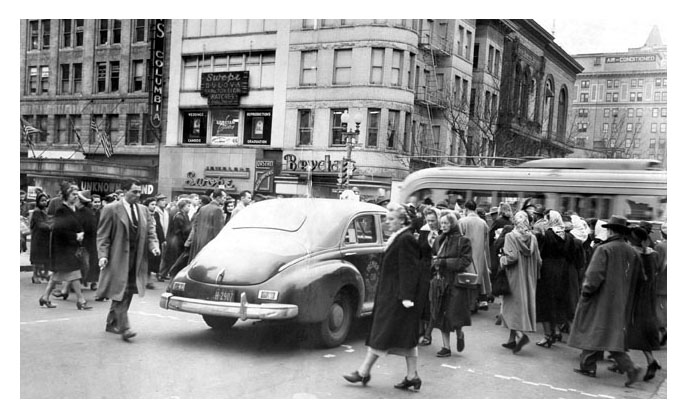License Plates and Registration Numbers
from March 1940 to March 1950
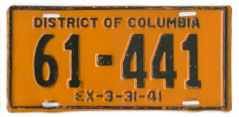 |
1940 March 1, 1940-March 31, 1941 |
 |
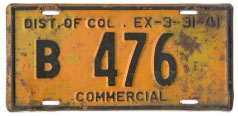 |
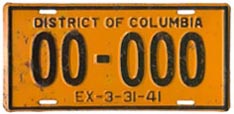 |
The only notable historical fact about 1940 District of Columbia license plates is that they were used for a 13-month period, not the standard (for the era) 12-month period. The extra month of use was required in order to shift the term of the registration year from March 1-Feb. 28 to April 1-March 31 (as explained on our introductory page). |
|
|
||||||||||||||||||||||||||||||||||||||||||||||||||||||
|
|
|
Passenger. An overview of registration numbers used from Jan. 1935-March 1948 is provided on our page upon which plates of the 1930s are described. Click here to get there. Specifically with respect to 1940, the lowest (five-digit) and highest observed numbers are 52-060 and 181-642.
Non-Passenger. Letter prefixes that appear on Commercial (Truck) plates (A and B are known for 1940) are believed to be indicative of the weight class upon which the registration fee was based. |
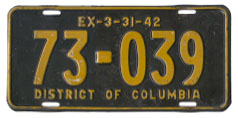 |
1941 April 1, 1941-March 31, 1942 |
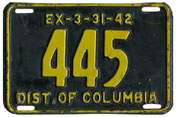 |
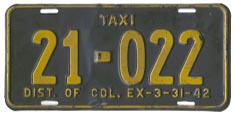 |
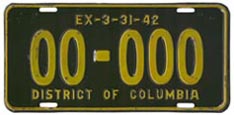 |
|
|
||||||||||||||||||||||||||||||||||||||||||||||||||||||
|
|
|
Passenger. An overview of registration numbers used from Jan. 1935-March 1948 is provided on our page upon which plates of the 1930s are described. Click here to get there. Specifically with respect to 1941, the lowest (five-digit) and highest observed numbers are 46-828 and 169-209.
|
1942 April 1, 1942 - March 31, 1943 |
1943 |
1944 April 1, 1944 - March 31, 1945 |
| Most 1942 (dated EX-3-31-43) plates were revalidated with metal tabs for two additional years, through March 1945. | ||
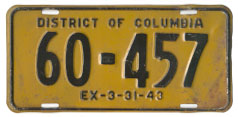 |
|
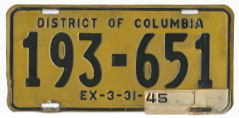 |
 |
|
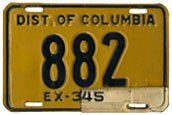 |
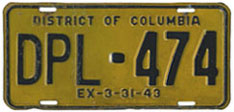 |
|
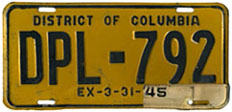 |
|
|
District of Columbia license plates issued during the spring of 1942 were used for three years, not one as were most previous issues, due to the conservation of metal used in non-military applications during World War II. Dated 3-31-43 plates were revalidated (when properly renewed) with metal tabs for the 1943 and 1944 registration years. The tabs were designed to appear correctly on full-size plates (those 12.5" in length), so they look awkward, partially covering the expiration date legend, on the shorter 9" plates. |
It is also worth noting that there are two styles in which the expiration date is displayed. Note the variation in this feature on plates 60-457 and 8370 pictured above. Number 8370 exhibits the more unusual style. The unusual, unexpected varieties in which 1942 Diplomatic plates were made, as pictured, are discussed near the bottom of our page dedicated to this type. |
|
|
||||||||||||||||||||||||||||||||||||||||||||||||||||||||||||||||||||||||||||||||||||
|
|
|
Passenger. An overview of registration numbers used from Jan. 1935-March 1948 is provided on our page upon which plates of the 1930s are described. Click here to get there. Specifically with respect to the 1942-44 base, the lowest (five-digit) and highest observed numbers are 57-221 and 215-478.
|
|
 |
1945 April 1, 1945-March 31, 1946 |
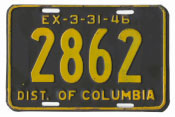 |
This is the only year since 1919 for which only a single D.C. license plate was issued for display on each registered vehicle. Plates were not issued in pairs in order to minimize the use of metal for non-military purposes. |
|
|
||||||||||||||||||||||||||||||||||||||||||||||||||||||
|
|
|
Passenger. An overview of registration numbers used from Jan. 1935-March 1948 is provided on our page upon which plates of the 1930s are described. Click here to get there. Specifically with respect to 1945, the lowest (five-digit) and highest observed numbers are 45-173 and 128-020. |
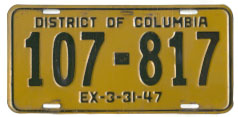 |
1946, '47 April 1, 1946-March 31, 1948 |
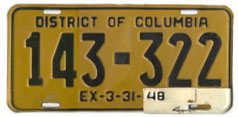 |
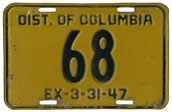 |
|
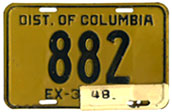 |
|
 |
|
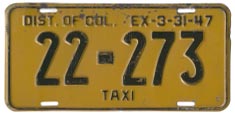 |
Washington, D.C. plates issued in the spring of 1946 were used for two registration years. As had been done a few years earlier, revalidation for the second year was accomplished by a dated steel tab made to cover the expiration year designation embossed in the plate. As there was for 1943 (dated "44") and 1944, the |
1947 (dated "48") tab used on this base comes in three styles. The passenger variety is made to fit in the lower right corner of the plate whereas a separate non-passenger variety, such as is shown on Commercial (Truck) plate no D-1870 below, is properly placed in the upper right corner. A third style (not shown) is designed to cover the entire left portion of motorcycle plates. |
|
|
||||||||||||||||||||||||||||||||||||||||||||||||||||||||||||||||||||||
|
|
|
Passenger. An overview of registration numbers used from Jan. 1935-March 1948 is provided on our page upon which plates of the 1930s are described. Click here to get there. Specifically with respect to the 1946-47 base, the lowest (five-digit) and highest observed numbers are 50-915 and 180-246.
|
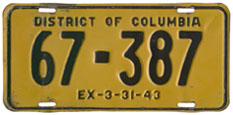 |
1942-44 (exp. 3-31-45) | |
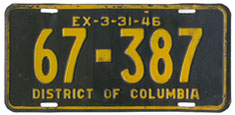 |
1945 (exp. 3-31-46) | |
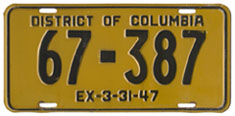 |
1946-47 (exp. 3-31-48) | |
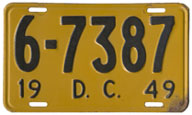 |
1949 (exp. 3-31-50) |
These four 1940s plates with the same number are direct evidence that plates with nondescript numbers were assigned to the same motorist year after year, although presumably only if the assignee arranged for it. Only the 1948 issue is missing from this set that otherwise covers eight consecutive years. |
|
||||
With so many six-digit registration numbers that were never needed, why DMV officials decided to revert to a numbering system similar to that of 1927-1934 for 1948 is a mystery. Although plates of this five-year period are not similar in appearance to pre-1935 plates, therir numbering is. Aside from the expansion of the quantity of all-number auto plates from 9999 to 9-9999, most details of the 1927-34 and 1948-52 numbering systems are the same. |
||||
|
|
|||
Passenger car plates of 1948 through 1952, and the 1953 base, are numbered 1 through 9-9999 (but without leading zeros to the right of the dash) and with certain letters followed by numbers 1 through 9999 (e.g. A-1 through A-9999). Because it was issued for two years, the 1953 base required an additional series that is discussed in the registration number section of that plate's dedicated section because it is unique to that base. The first series of each year, the all-number plates, are marked 1 through 9999, followed by 1-1000 through 1-9999, 2-1000 through 2-9999, etc. ending at 9-9999. Which of these all-number plates may have been reserved for particular motorists from year to year is addressed below. The number of possible registration numbers is addressed in each separate year section because that maximum potential differs depending on the number of letters dedicated to passenger plate use. As discussed in the next column, certain numbers were reserved only for non-passenger use. Reserved Numbers. One of the questions yet to be answered about auto plate numbers (and earlier years) relates to what today is unofficially referred to as the reserved series of passenger registrations. Numbers 1 through 1250 are now the only passenger numbers issued (although higher numbers can be ordered as personalized plates), and individuals to whom these reserved numbers are assigned is specified annually by members of the city council and other officials. Reserved numbers are known to have existed back into the 1930s, and presumably the lowest D.C. registration numbers were reserved for particular individuals since plates were first issued annually in 1918, but which numbers were actually reserved for most years is unknown. The conventional wisdom (assuming this question has been considered at all) is that all numbers 1 through 9999 were included in the reserved number program, whatever its form, from 1935 through early 1955 (upon the expiration of 1954 registrations). However, that enough D.C. motorists were interested in reserved numbers during these years to justify the use of resources needed to complete the recordkeeping and administrative tasks that would have been required to monitor the assignment of 9,999 numbers annually seems doubtful. It is therefore more likely that some lower span of numbers, such as 1 through 1000, were reserved and carefully assigned annually, and that higher numbers, up to 9999, were randomly assigned. In fact, we know that numbers 1 through 1000 were reserved for asignment by the Board of Commissioners for the 1955 registration year (as discussed separately in our 1955 plate section), so it is reasonable to assume that the same numbers, or a similar group, were reserved in 1954 and earlier registration years. It is also reasonable to assume that certain registrations with letter prefixes were included, either formally or informally, in the reserved-number program. For example, low numbers such as A-1 through A-10, E-1 through E-10, etc. were likely assigned to VIPs, especially those with surnames that began with particular letters, and is not unreasonable to assume that these numbers went to the same motorists year after year. Click here to read about how even nondescript five-digit numbers were assigned to the same motorists from year to year. |
After a period of more than ten years during which the registration type of most vehicles was clearly marked on the plate, the embossed type designations were abandoned for 1948 in favor of letter prefixes. A letter B prefix was used to identify Bus plates throughout this era. Numbers were assigned sequentially beginning at B-1 annually. A letter C prefix was used to identify Commercial (Truck) plates throughout this era. Numbers were assigned sequentially beginning at C-1 annually, and when they reached C-9999 a serial letter was added after the C, presumably beginning at CA-1 and proceeding as high as necessary. A letter D prefix was used to identify Dealer plates throughout this era. Numbers were assigned sequentially beginning at D-1 annually, and throughout this era many dealers riveted their registration certificate to the back of the plate in a clear plastic sleeve. Plates that begin with DPL were assigned to members of the Diplomatic Corps throughout this era. Numbers were assigned sequentially beginning at DPL-1 annually. A letter G prefix was used to identify plates affixed to D.C. Government-owned vehicles for the 1948 through 1951 registration years. Numbers were assigned sequentially beginning at G-1 annually. For 1952 and later years a separate, distinctive D.C. Government plate was issued, and the letter G became a passenger plate prefix. A letter H prefix was used to identify Hire (Taxi) plates throughout this era. Numbers were assigned sequentially beginning at H-1 annually. A letter L prefix was used to identify Livery plates throughout this era. Numbers were assigned sequentially beginning at L-1 annually. Most DMV documents in which Livery plates are discussed make the distinction that plates of this type were issued for use on "sightseeing, funeral cars, chartered busses, etc." A letter M prefix was used to identify Motorcycle plates throughout this era. Numbers were assigned sequentially beginning at M-1 annually. A letter R prefix was used to identify Rental Car plates throughout this era. Numbers were assigned sequentially beginning at R-1 annually. A letter T prefix was used to identify Trailer plates throughout this era. Numbers were assigned sequentially beginning at T-1 annually. |
|||
 |
1948 April 1, 1948-March 31, 1949 |
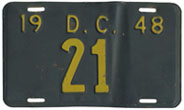 |
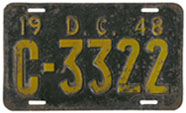 |
 |
 |
A number of noticeable changes were made to District of Columbia license plates for the 1948 registration year. Most noteworthy, perhaps, is the change in the manner in which they are dated. Whereas since 1939 (exp. 2-29-40) D.C. plates were marked with the expiration date, effective April 1948 the designation was changed to indicate the year of issuance. Despite the change, the registration year remained the same: April 1 through March 31. Click here to reach our page devoted to changes made for 1948, and here to read about the sometimes confusing manner in which the period of use was |
marked on D.C. plates of 1939 through 1953. Also for 1948, a uniform plate size was introduced, and passenger car registration numbers began to include letters again (as they had from 1927-1938). Specifically, auto plates were numbered 1 through 9999; then 1-1001 through 1-9999, 2-1001 through 2-9999, etc. through 9-9999; then A-1 through A-9999, E-1 through E-9999, etc. Certain letters were set aside for use on non-passenger plates, such as B, C, and D for busses, commercial vehicles, and dealer-owned vehicles, respectively. |
|
|
||||||||||||||||||||||||||||||||||||
|
|
|
An overview of registration numbers used from April 1948-March 1955 is provided above. Passenger. These six prefix letters have been observed on 1948 auto plates: A, E, F, J, K, and N. If it is assumed that no other prefix letters were used this year and including the 99,999 plates without a letter prefix (numbers 1 through 9-9999), there are a total of 159,993 possible passenger registration number combinations. The highest observed number is N-985. Non-Passenger. Refer to the text above for information about to which non-passenger types plates with prefix letters B, C, D, G, H, L, M, R, and T, as well as DPL, were assigned. |

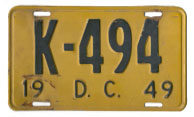 |
1949 April 1, 1949-March 31, 1950 |
 |
 |
 |
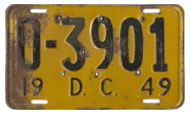 |
 |
 |
A July 1950 Evening Star article indicates that “During the year that ended last April, 215,700 sets of license tags were handed out at the Department of Motor Vehicles and Traffic - 15,000 more than in the previous year. And 85,000 car titles were issued - 2,500 more than during the year before.” “...About 350 sets of tags and a like number of titles are passed out each day.” |
|
|
||||||||||||||||||||||||||||||||||||
|
|
|
An overview of registration numbers used from April 1948-March 1955 is provided above. Passenger. These seven prefix letters have been observed on 1949 auto plates: A, E, F, J, K, N, and P. If it is assumed that no other prefix letters were used this year and including the 99,999 plates without a letter prefix (numbers 1 through 9-9999), there are a total of 169,992 possible passenger registration number combinations. The highest observed number is P-6930. Non-Passenger. Refer to the text above for information about to which non-passenger types plates with prefix letters B, C, D, G, H, L, M, R, and T, as well as DPL, were assigned. |
|
This page last updated on December 31, 2017 |
 |
|
copyright 2006-2018 Eastern Seaboard Press Information and images on this Web site may not be copied or reproduced in any manner without consent of the owner. For information, send an e-mail to admin@DCplates.net |














